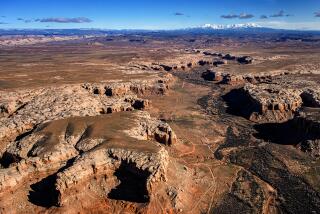Wildlife Refuges: Compromise Helps but Environmental Debate Goes On
- Share via
LEROY, Wis. — Honking contentedly, their wings beating a rhythm that signals no urgency, the Canada geese are returning as the sun casts a glow across the marsh water. After gleaning the cornfields as far as 30 miles to the east, they will roost for the night in the silence of the reeds.
The habitat the flocks find here at the largest protected freshwater marsh along the Midwest’s waterfowl highway is at the core of a five-year debate coming to a head in Congress: Should U.S. wildlife preserves give those who maneuver on two feet--not to mention on bicycles, skimobiles and Jet Skis--the same standing as those dependent on wings, fins or paws?
A year ago, Rep. Don Young (R-Alaska), chairman of the House Resources Committee, won House approval of a plan that would have elevated recreational pursuits to an equal footing with wildlife conservation.
“The real goal,” said George Frampton, until recently an assistant secretary of the Interior, was “to make hunting and fishing and certain economic activities--military uses, the possibility of oil and gas development or grazing--on a par with wildlife protection, to make it at least an even balance.
“This is not what Theodore Roosevelt had in mind” when he established refuges in 1903, Frampton added.
The plan died because it was never acted on by the Senate, and Young began the congressional session this year again pressing for approval of the plan. He faced intense White House opposition.
As Interior Secretary Bruce Babbitt told Young’s committee: “Unlike other areas, where wildlife is shunted aside by the relentless forces of the bulldozer, chain saw and plow, the conservation of wild creatures, large and small, reigns supreme in wildlife refuges. In wildlife refuges, the conservation needs of wildlife are paramount.”
Joining Young on the other side was Democratic Rep. John D. Dingell of Michigan, long a congressional anchor among hunting and fishing enthusiasts but also sympathetic to environmental concerns.
As the debate joined anew, Babbitt earlier this spring summoned congressional aides, officials of state fish and game agencies and representatives of hunting, fishing and environmental organizations for a series of negotiations that quietly cut through what one participant called the “weirdness and suspicion . . . paranoia and accusations of dark scheming” to find common ground.
What they came up with was legislation that states five wildlife-dependent recreation activities are the leading priorities for refuges: environmental education, bird watching, photography, hunting and fishing. But the measure offers only one overriding purpose, in Babbitt’s words: “The conservation of wildlife. Period.”
“The sportsmen wanted legislative recognition of their role in the refuge system. They’ve had an enormous one,” Babbitt said in an interview. “But they’ve never had a formal legislative acknowledgment, and they’ve been getting uneasy as they hear environmentalists say refuges are not a place for hunting and fishing. They were looking for some security.”
The environmentalists had wanted formal recognition that the refuges’ raison d’etre was the protection of wildlife and that whatever recreation was permitted in the sanctuaries had to be compatible with that goal, said Jim Waltman, a wildlife specialist with the Wilderness Society in Washington.
The result, thus far, has been a consensus rare within Congress and rarer still in the emotional arena of environmental legislation. The compromise sets forth for the first time in three decades the uses to which the nation’s 509 wildlife refuges can be put.
Representatives of hunting and fishing groups, which had supported Young’s original effort, say they are content.
“The next time the animal-rights crazies come after us,” the new language would offer “a statutory shield against future litigation to terminate hunting and fishing in the refuges,” said Bill Horn, national affairs director of the Wildlife Legislative Fund of America.
“This is a defensive gesture on our part to build these activities into law,” said Horn, whose group is dedicated to protecting opportunities to hunt, trap and fish--in this case, in wildlife refuges.
The compromise notwithstanding, the issue raises the profile of the popular but often-misunderstood system of refuges: marshes, forests, beaches and deserts. It puts them in the sunlight of a political debate that goes to the heart of the nation’s environmental agenda and asks what benefit comes from preserving land in its natural state.
The marsh here, five miles wide and 13 1/2 miles long, was carved into the landscape 12,000 years ago by a retreating glacier. It presents a before-and-after case in which to consider the question.
As quiet as the marsh is on a weekday in spring, when the herons, egrets, geese, cormorants, coots and terns have begun arriving ahead of human visitors, consider it in the autumn. Then the birds are leaving en masse, and many of the site’s 400,000 annual visitors--or as many as 550,000 by one survey--arrive to watch the start of the southbound migration.
Wisconsin’s Department of Natural Resources manages the marsh’s southern third. The U.S. Fish and Wildlife Service manages the larger northern segment. All but the most experienced visitor to this setting amid rolling farmland would be unable to notice a difference between the two segments.
The Horicon Marsh State Wildlife Area is not a theme park; shotgun reports and the angry tenor of Jet Skis do not tear through the solitude. Nor is the Horicon National Wildlife Refuge to the north a fenced-off Eden. Limited hunting is allowed there, as it is to the south, and some of its paths are open to hikers.
But life for humans in the federal territory is more restricted: Many areas are closed to all visitors, most hunting is limited and--unlike in the southern segment--all waterfowl hunting is prohibited.
William K. Volkert, a state wildlife educator and naturalist, has tracked the debate over the role of the wildlife refuges in the inventory of state and federal lands.
“We already have federal parklands where recreation is primary,” he said. “The national parks, the national forests, the scenic river system: They’re recreational sites. What we’ve tried to do [in the wildlife refuges] is take the most fragile systems and set some aside to keep the wildlife there.”
Nearby in the Kettle Moraine state forest, Volkert said, he and other state officials listed 86 common recreational pursuits that take place. Among them are not only picnicking, horseback riding and nature photography but also water sports: sailing, speedboat racing and riding Jet Skis. Then there are motorcycles, all-terrain vehicles and in-line skates.
The use of nature’s spaces is for more than “just an army of bird watchers,” he said. “It’s our public land, and whatever newfangled toys people will come up with, why should we deny it?”
But, he said, when faced with an alternative that “says all North America is a playground for people,” it is time to think about limits.
More to Read
Sign up for Essential California
The most important California stories and recommendations in your inbox every morning.
You may occasionally receive promotional content from the Los Angeles Times.










